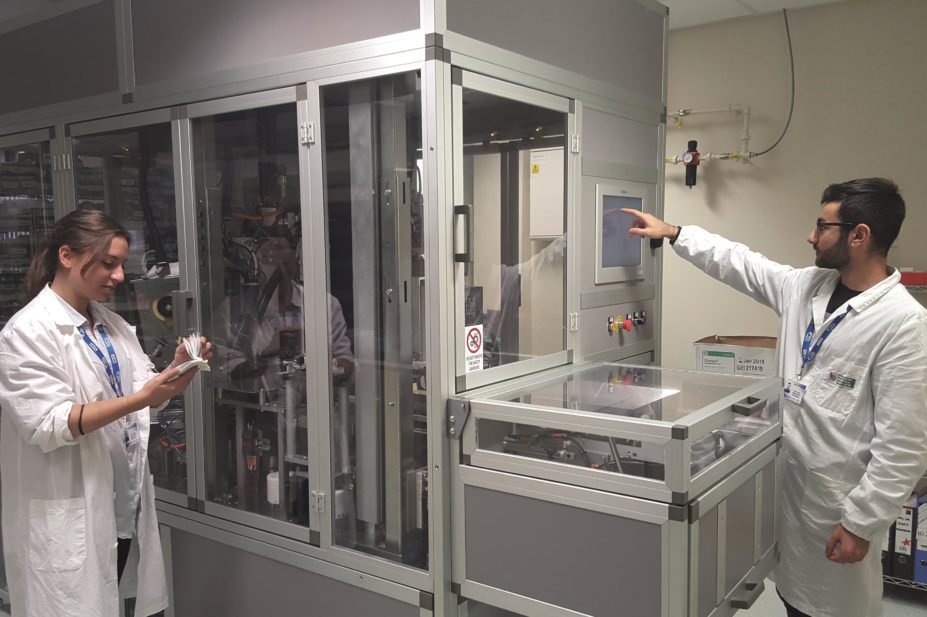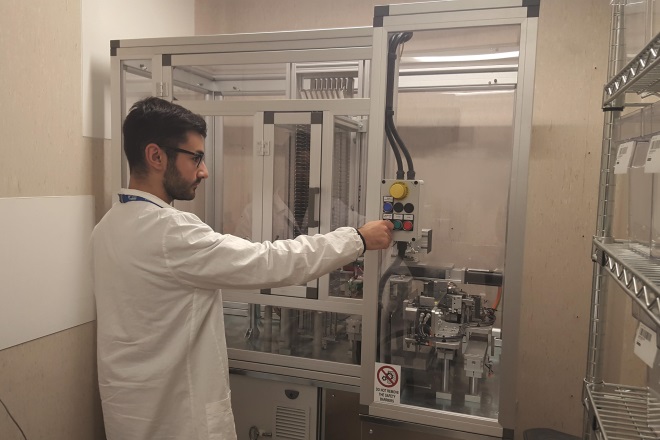
University Hospitals of Leicester NHS Trust / IBSL(UK)
The introduction of a unit-dose medicines packing, distribution and administration system at University Hospital of Leicester (UHL) has streamlined the work of nurses on the renal wards, according to senior nurses at the hospital.
“Drug rounds are now more efficient and less frustrating,” said Mary Guinan, UHL’s senior nurse in renal medicine, at Robotics 2015, a conference held in Birmingham on 26 November 2015.
The UHL system, developed in collaboration with Ingegneria Biomedica Santa Lucia whose original system has already been used across 15,000 beds at 20 hospital sites in Italy, comprises a number of interlinked robots together with prescribing and logistics software. The first robot cuts sheets of blister-packed medicines into individual doses without opening the blisters. A second robot packs the doses into sachets, each labelled with a barcode, product description, batch number and expiry date. These unit-dose sachets are stored in a ward-based robot that automatically loads individual patient drawers in the medicines trolley in preparation for a medicines round and can be used to issue individual ‘as required’ or urgent doses.
It is estimated that approximately 85% of medicines stocked by a hospital pharmacy could be repackaged as unit doses, according to Gill Hartley, principal pharmacist in renal services and critical care at UHL.
To administer a medicine, the nurse scans the patient’s barcoded wristband to bring up their electronic prescription and to open their drawer. The medicine is then scanned to confirm a match with the prescription. This closed-loop process has “removed the potential for error”, making medicines administration much safer, Guinan said.
The electronic prescribing software produces “a recognisable drug chart” that is intuitive and easy to follow, explained Jackie Elton, medicines management nursing lead at UHL. The previous paper-based system often called for the use of two or three charts and it was not uncommon for mix-ups and under-dosing or double-dosing to occur, she added.

Source: University Hospitals of Leicester NHS Trust / IBSL(UK)
Andrea Chiarenza, a UHL robotics technician, operates the blister cutting robot
One important advantage of the system comes from “not having to look for lost drug charts”, said Elton, who estimates that nurses spend around ten minutes searching for drug charts during every drug round. Extrapolated to the whole of the NHS, this equates to an annual sum of more than £400,000 worth of nursing time being spent looking for lost charts, she said.
More than 2,000 medicines rounds have been completed since the project was started, with the scheme contributing to the hospital’s objective of “freeing nursing time to nurse”, said Ms Elton.
The system also means that medication storage is more efficient and reliable. Daily restocking of the ward-based robot by pharmacy staff means that ward staff no longer spend time looking for medicines or going to the pharmacy to collect supplies, nor do they need to hoard supplies of medicines in unofficial locked cupboards, said Guinan.
Hartley said the discharge procedure is also more efficient under the new system, because patients are given unit-dose drugs and their own medicines are not used during their hospital stay. This means the pharmacy is less likely to need to supply fresh 28-day packs when patients are discharged. Frequent rewriting of medicines charts is also no longer necessary and, as a result, discharge letters and prescriptions are prepared in advance and there is more time for patient counselling.
The system has been in operation on four wards in the renal unit at UHL since April 2015. Preliminary results show that medicines’ expenditure on the wards has been reduced by 12–29%. The number of items dispensed each day has decreased by 45–60% and the number of duplicate items dispensed has decreased by 37–45%. Duplicate dispensing occurs when items apparently ‘go missing’ after having been dispensed and supplied to a ward. It is often quicker to re-dispense than to search for the items, explained Hartley.
The project is run by UHL in collaboration with Ingegneria Biomedica Santa Lucia, Loughborough University and the East Midlands Academic Health Sciences Network, which is funding a full economic evaluation.


